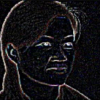Free Online Productivity Tools
i2Speak
i2Symbol
i2OCR
iTex2Img
iWeb2Print
iWeb2Shot
i2Type
iPdf2Split
iPdf2Merge
i2Bopomofo
i2Arabic
i2Style
i2Image
i2PDF
iLatex2Rtf
Sci2ools
CVPR
2007
IEEE
2007
IEEE
Biased Manifold Embedding: A Framework for Person-Independent Head Pose Estimation
The estimation of head pose angle from face images is an integral component of face recognition systems, human computer interfaces and other human-centered computing applications. To determine the head pose, face images with varying pose angles can be considered to be lying on a smooth low-dimensional manifold in high-dimensional feature space. While manifold learning techniques capture the geometrical relationship between data points in the highdimensional image feature space, the pose label information of the training data samples are neglected in the computation of these embeddings. In this paper, we propose a novel supervised approach to manifold-based non-linear dimensionality reduction for head pose estimation. The Biased Manifold Embedding (BME) framework is pivoted on the ideology of using the pose angle information of the face images to compute a biased neighborhood of each point in the feature space, before determining the low-dimensional embedding. The proposed BME approach...
Computer Vision | CVPR 2007 | Head Pose Angle | Head Pose Estimation | Pose Angle Estimation | Pose Angle Information | Pose Angles |
| Added | 12 Oct 2009 |
| Updated | 28 Oct 2009 |
| Type | Conference |
| Year | 2007 |
| Where | CVPR |
| Authors | Vineeth Nallure Balasubramanian, Jieping Ye, Sethuraman Panchanathan |
Comments (0)

